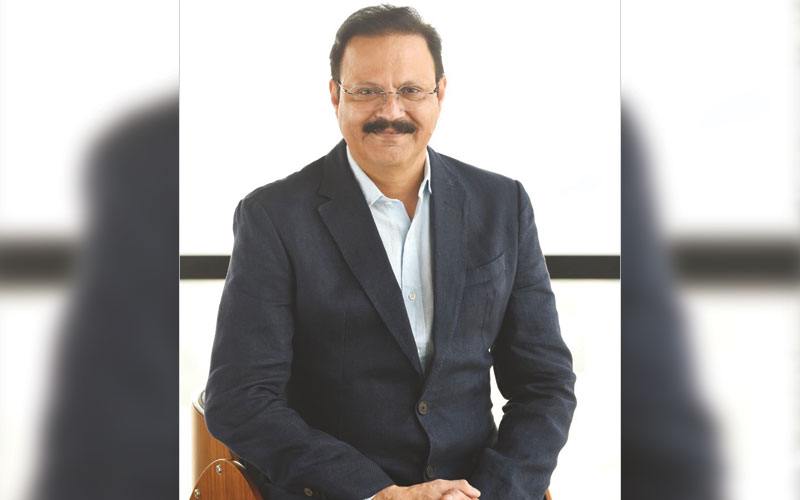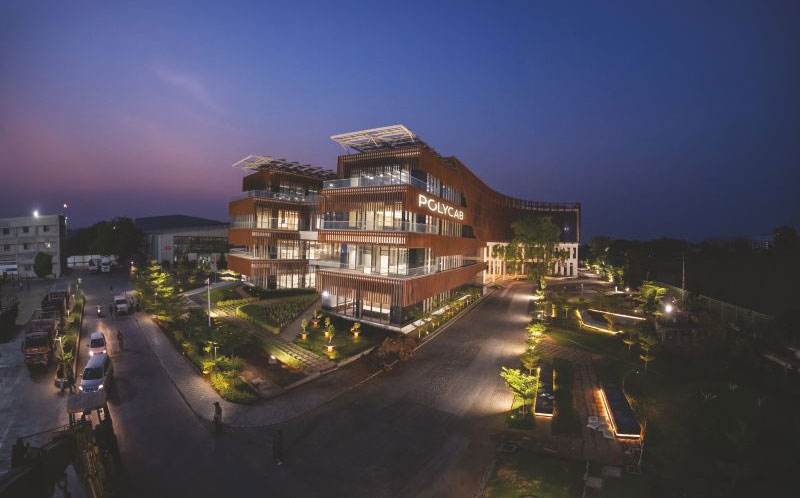In the digital age, data has become an indispensable part of economies worldwide, and India is no exception. With a burgeoning population of tech-savvy users, an explosion of digital services, and government initiatives pushing for greater digital adoption, the demand for data centres in India has soared. The advent of Edge Computing, 6G data networks, and hyperscale data centres have further reshaped the digital landscape. However, behind the scenes of this digital revolution lies a crucial component that forms the backbone of data transmission: wires and cables. Read the article to discover what Mr. Bhushan Sawhney, Executive President & Chief Business Officer, Polycab India Limited, has to share on the subject.

Wires & Cables: The Backbone of Data Transmission
The convergence of wires, cables, and data is proving to be the driving force behind the next wave of data centre growth in the country. As data volumes continue to skyrocket and the need for faster, more reliable connectivity becomes paramount, the role of these seemingly mundane components becomes increasingly vital. High-quality cables and wires serve as an essential element of data centres, facilitating seamless communication and power distribution across extensive networks of servers and storage systems.
According to forecasts by Statista, the revenue in the data centre market in India is poised to witness a substantial surge, reaching $9.88 billion by 2028. This growth trajectory is underscored by significant investments in network infrastructure, servers, and storage systems.
The deployment of intelligent systems and real-time data transfer necessitates the use of cables capable of withstanding heavy power loads while ensuring optimal energy efficiency. Furthermore, the construction of raised floors in data centres provides an ideal conduit for routing communication and power cables, underscoring the importance of lightweight yet durable wiring solutions.
The communication and power cables are routed through raised floors in the data centres. This requires cables to be made of lightweight material, with construction providing additional strength, durability, and protection against damage. The cables and wires should be able to support heavy power loads and provide protection against static electricity, moisture, and other hazards. In line with this, manufacturers are continuously innovating to produce cables that are not only durable but also flexible, adaptable, and energy efficient.
Moreover, with enterprises’ growing need for digital infrastructure that supports the storage of large data volumes, leading and emerging service providers must design data centres with high-density capabilities. For high-density needs, an operator should be able to accommodate high-power draws without significant reconfiguration or additional power infrastructure. This means the use of high-quality, highly power-efficient cables that can manage the load requirements without significant power losses. In the mission-critical environment of data centres, reliability and resilience are paramount. Downtime can result in significant financial losses and damage to reputation, making it imperative for data centre operators to invest in robust cabling infrastructure that can withstand the rigours of continuous operation.
High-quality cables and wires undergo rigorous testing and certification processes to ensure compliance with industry standards for performance, reliability, and safety. These standards dictate parameters such as signal integrity, fire resistance, and electromagnetic compatibility, which are critical for maintaining uninterrupted operation in data centre environments.
Furthermore, redundancy and fault tolerance strategies are employed to mitigate the risk of cable failures. Data centre designs often incorporate redundant cabling paths, backup power supplies, and failover mechanisms to ensure seamless operation in the event of a cable or component failure. These redundancies are essential for maintaining uptime and preserving the integrity of operations.
Watch: RR Kabel | Solar Cables | Solar Plant | Renewable Energy
Emerging Trends Shaping the Future
In addition to the foundational role of cables and wires in data centre infrastructure, emerging trends are shaping the future of cabling solutions in India’s data centre landscape. These trends are driven by evolving technologies, changing industry requirements, and a growing emphasis on efficiency and sustainability.
With the increasing demand for higher computational power and storage capacity within data centres, the need for high-density cabling solutions is becoming a must-have. High-density cabling allows for more efficient use of rack space and improved airflow management, leading to enhanced cooling efficiency and reduced energy consumption. Manufacturers are developing compact and flexible cabling systems to accommodate the dense configurations of modern data centres.
Fibre Channel over Ethernet (FCoE) is gaining traction as a cost-effective and scalable solution for data centre networking. By converging Fibre Channel storage traffic and Ethernet data traffic onto a single cabling infrastructure, FCoE simplifies network architecture and reduces hardware and maintenance costs. This technology enables seamless integration of storage and networking resources, streamlining data centre operations, and enhancing overall efficiency.
Modular cabling systems offer greater flexibility and scalability, allowing data centre operators to easily adapt to changing infrastructure requirements. These systems consist of pre-terminated cables and modular components that can be quickly installed and reconfigured as needed. By minimizing installation time and complexity, modular cabling systems help reduce downtime and improve overall agility in data centre deployments.
As energy efficiency becomes a top priority for data centre operators, there is a growing demand for energy-efficient cabling solutions. Manufacturers are developing cables and connectors with lower power consumption and improved thermal performance, helping to reduce cooling requirements and operational costs. Additionally, technologies such as Power-over-Ethernet (PoE) enable the delivery of both power and data over a single cable, further enhancing energy efficiency and reducing the overall carbon footprint of data centres.
Effective cable management is essential for optimizing airflow, preventing cable congestion, and facilitating efficient maintenance and troubleshooting in data centres. Advanced cable management systems incorporate innovative features such as cable trays, routing guides, and labelling solutions to ensure tidy and organized cabling infrastructure. By minimizing cable clutter and improving accessibility, these systems ensure overall reliability and performance in data centre environments.
Geographic Landscape and Key Hubs
Location is the key determining factor for an enterprise’s data centre colocation provider. The industry is witnessing significant shifts in the data centre ecosystem and the attractive locations for building new facilities, driven by several factors such as shortage of available land and power that inhibits the growth of the data centre supply in traditional, mature locations; increasing digital transformation and outsourcing in emerging markets. The shift in supply-demand dynamics is also giving rise to new locations that can be monetized with high utilization rates. All these factors work in favour of India which puts it at the forefront of the emerging markets.
Currently, Mumbai, Delhi NCR, Hyderabad, Chennai, and Bengaluru stand out as focal points of data centre activity, each offering unique advantages in terms of infrastructure, connectivity, and accessibility. Mumbai as the largest data centre hub in India, boasts robust network infrastructure and international fibre connectivity, making it an ideal location for data centre deployments. Similarly, Chennai’s strategic geographic proximity to key Asian cities and coastal advantages position it as an emerging hyperscale data centre hub.
Mumbai has approximately one-fourth of the total data centres and almost half of the colocation capacity. Being the financial capital and main gateway to international markets, Mumbai has been the preferred choice for data centre deployments in India. More than 12 subsea landing stations for global network nodes in India are installed here. On the demand side, the Mumbai region houses major business districts and financial institutions along with a large population that would support data demand. On the infrastructure side, the region has two international fibre landing stations, strong power connectivity and power infrastructure in place. The large scale, attractive location, and strong facilities would continue to help Mumbai in securing contracts at attractive yields, thereby supporting its utilization levels and profitability.
Chennai is an emerging hyperscale data centre hub in India, with more than $1.5 billion in planned investments from global and domestic data centre providers to build data centres in the next few years. It has better geographic proximity to key Asian cities such as Singapore, Seoul, and Hong Kong, with 8+ subsea cable landing stations. It is a preferred disaster recovery location for enterprises. It is a coastal area that enables the establishment of a subsea cable landing station. It has relatively lower real estate and power costs.
Delhi NCR offers one of the best metro fibre connectivity. With the Government of India’s push for a digital economy, data centre developments in Delhi will fulfil many of its digital requirements. The city is home to a major chunk of government agencies and PSUs. Bengaluru is home to 15% of colocation data centres in India. Several colocation service providers such as STT GDC India, NTT Netmagic, and CtrlS, are further expanding their capacities in Bengaluru. Bengaluru has a highly skilled workforce and is considered the hub of the IT/ITeS industry in India, one of the top two verticals generating the highest demand for data centre services in India.
As India continues to solidify its position as a data centre powerhouse, the convergence of wires, cables, and data emerges as a driving force behind the next wave of data centre growth. The symbiotic relationship between these elements underscores the importance of holistic infrastructure solutions in meeting the evolving needs of the digital economy.
Charting a Transformative Path
In conclusion, the future of data centre growth in India hinges on a multifaceted approach that integrates cutting-edge technology, energy-efficient infrastructure, and sustainable practices. By harnessing the trifecta of wires, cables, and data, India is poised to chart a transformative path towards digital innovation and leadership on the global stage. As we navigate this exciting journey, collaboration between industry stakeholders, policymakers, and innovators will be paramount in realizing the full potential of India’s data centre ecosystem. With the right investments in cables, wires and data infrastructure, India can emerge as a global leader in the data centre industry, driving innovation, economic growth, and sustainable development.





